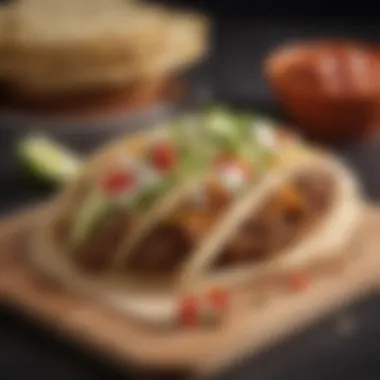Exploring the Versatility of Taco Bell Flatbread


Intro
Taco Bell's flatbread has emerged as a significant component in the fast food landscape, captivating numerous consumers with its adaptability. It offers a unique base that can transcend traditional boundaries, introducing various flavors and ingredients in innovative ways. This culinary exploration will assess the distinctive elements of flatbread, its diverse applications in recipes, and how it aligns with current dietary trends.
In this article, the multifaceted nature of Taco Bell's flatbread will be dissected, revealing its potential beyond simple wrappers for tacos or burritos. From intriguing recipes to potential nutritional implications, our assessment is aimed at enriching the reader's understanding of this fast food staple and its varied uses. The exploration begins with an overview of recipes that can utilize Taco Bell's flatbread, immersing readers in creative applications.
Recipe Overview
Recipe Name
Flatbread Quesadilla
Cuisine Type
Mexican Fast Food
The Quesadilla embraces simplicity while showcasing the core strengths of Taco Bell’s flatbread. This combination offers a delightful textural contrast and a chance to experiment with fillings.
Ingredients
- 2 Taco Bell flatbreads
- 1 cup shredded cheese (cheddar or mozzarella)
- 1/2 cup cooked chicken, diced
- 1/4 cup sliced bell peppers
- 1/4 cup onion, chopped
- Optional: salsa or sour cream for serving
Substitutions for Common Ingredients
- Cheese: Vegan cheese can be used for a dairy-free option.
- Chicken: Substitute with black beans or grilled vegetables for a vegetarian version.
- Salsa: Any favorite hot sauce can replace salsa for an added kick or flavor.
This recipe embodies the principle of versatility, as it can cater to a variety of dietary preferences while maintaining an authentic Mexican fast food experience.
Taco Bell flatbread is not only flexible in taste but also in its ability to complement diverse ingredients. Its role in contemporary fast food showcases innovation driven by consumer demands.
The use of flatbread opens doors to multiple culinary avenues, inviting experimentation and personalization according to taste and dietary restrictions.
Prologue to Taco Bell Flatbread
Taco Bell flatbread has become an intriguing element in the fast-food landscape. Its role extends beyond just a simple carrier for food; it serves as a versatile canvas for various culinary creations. This section emphasizes the significance of Taco Bell flatbread in contemporary dining, focusing on its ability to cater to diverse tastes and preferences.
The Emergence of Flatbread in Fast Food
Flatbreads have roots in many cultures, yet their recent rise in fast food is notable. Fast-food chains have sought ways to innovate their menus. Taco Bell embraced flatbread as a functional and appealing alternative to traditional tortillas and buns. This emergence reflects a broader trend in the industry that favors unique textures and flavors, providing customers with more than just a basic meal.
Flatbread’s presence has been marked by its adaptability. Many customers appreciate the flexibility it offers—serving as a base for tacos, quesadillas, or wraps, it accommodates various fillings and toppings. The introduction of Taco Bell flatbread aligns with evolving tastes, as diners seek out meals that are both delicious and unique. Moreover, its ability to absorb flavors without becoming soggy enhances the overall dining experience.
Flatbread's Unique Qualities
Taco Bell flatbread possesses distinct characteristics that set it apart from other offerings. One prominent feature is its texture. Unlike standard tortillas, the flatbread has a slightly crisp exterior while retaining a soft interior. This duality enhances mouthfeel, providing a satisfying crunch before yielding to a tender bite.
In addition to texture, the flavor profile of this flatbread is noteworthy. It complements ingredients without overpowering them. The subtle taste allows for a versatile pairing with various fillings, from savory meats to fresh vegetables. This balance makes it suitable for different culinary creations, ensuring versatility across the menu.
Moreover, Taco Bell's flatbread can be easily customized. Customers can opt for different sauces, cheeses, or other toppings, enhancing the dining experience. This customization aspect aligns with current trends where personalization in food has become increasingly popular. It also reflects Taco Bell’s commitment to catering to varying dietary needs and preferences.
"Flatbread’s versatility in fast food creates opportunities for innovative dishes, meeting the demands of a diverse customer base."
In summary, Taco Bell flatbread stands as a significant player in the fast-food sector. Its emergence marks a shift towards more adaptable menu options. With its unique qualities in texture and flavor, flatbread provides an appealing alternative that resonates with food lovers eager for innovation.
Culinary Applications of Flatbread


The culinary versatility of Taco Bell flatbread extends beyond its primary role as an accessory to traditional menu items. Understanding its broad applications can enhance the dining experience and offer more variety for consumers. Taco Bell flatbread can be adapted to suit various tastes and preferences, making it a valuable component in many meals.
As a Base for Tacos and Wraps
Flatbread serves as an excellent foundation for tacos and wraps, presenting a unique texture and flavor that complements a range of fillings. Unlike conventional taco shells, flatbread offers a softer, more pliable surface, allowing for easier handling and consumption. The flexibility of flatbread makes it ideal for wrapping various ingredients together.
Fillings can include seasoned meat, fresh vegetables, and flavorful sauces. For those seeking healthier options, substituting traditional protein with grilled chicken or even plant-based alternatives can make a significant difference. The flatbread’s neutral taste allows the dominant flavors of the fillings to shine through, creating a delightful balance.
Flatbread in Salads and Bowls
Incorporating flatbread into salads and bowls is another innovative application worth mentioning. By cutting the flatbread into strips or pieces, it can act as a crunchy topping or even a base layer within a salad. This addition can enhance both texture and substance, transforming a simple salad into a more filling meal.
Flatbread can also be served alongside rice or quinoa bowls. It complements various ingredients, such as beans, veggies, and dressings, providing a comforting element to the dish. This approach caters to those who seek a more hearty or diversified meal that balances freshness with satisfying elements.
Alternative Uses in Gourmet Dishes
The creativity does not halt at traditional offerings; flatbread can be utilized in gourmet culinary applications as well. Chefs have begun to experiment with flatbread in a variety of upscale menus. By adopting flatbread for pizza bases, flavorful toppings can make an everyday meal feel gourmet. This method allows for endless combinations of ingredients, from spicy pepperoni to artisanal cheeses, alongside fresh herbs and vegetables.
Additionally, flatbread can be repurposed in desserts. For instance, using flatbread as a crust for a fruit tart or combining it with sweet spreads can elevate a simple treat into something appealing and delicious. By stepping outside conventional uses, Taco Bell flatbread can inspire creativity in the kitchen.
The adaptability of Taco Bell flatbread showcases its potential in enhancing various dishes, appealing to a wide array of culinary preferences.
Nutritional Considerations
Understanding the nutritional aspect of Taco Bell flatbread is essential for making informed dietary choices. Flatbread is often seen as a flexible option, and it can cater to various dietary needs and preferences. This section explores significant factors concerning its caloric content, ingredients, and customization opportunities.
Caloric Content and Ingredients
The caloric content of Taco Bell flatbread is an important factor to consider. Generally, a serving of flatbread may contain around 200 to 250 calories. This number can fluctuate based on the preparation and what ingredients are added to it. Flatbreads are typically made from flour, water, and salt, with some possibly containing preservatives or other flavor enhancers. These ingredients can also impact the texture and taste, making it appealing for many.
Moreover, choosing the right toppings is crucial. Some commonly added ingredients include meats, cheeses, and sauces. Each of these can significantly alter the overall caloric count. For instance, a flatbread loaded with grilled chicken and cheese can elevate caloric intake, while a more minimally topped option would be lighter. This knowledge can guide consumers in selecting the most suitable option according to their dietary aspirations.
"Mindful consumption is key for any fast food. Understanding what's on the plate helps in making better choices."
Dietary Options and Customizations
Flatbread at Taco Bell offers a range of customization options to suit various dietary preferences. There are vegetarian variations available, such as the Black Bean Flatbread. This provides a protein-rich alternative for those avoiding meat.
Additionally, Taco Bell accommodates gluten-free needs with specific ingredients that are less likely to contain gluten. However, it is wise for customers to inquire about potential cross-contamination, as fast-food environments often have shared utensils and preparation areas.
Another appealing aspect is the option to customize orders. Patrons can ask for fewer toppings, swap out sauces, or even request specific ingredients to enhance nutritional value. This flexibility allows individuals to tailor their meals to meet personal caloric and nutritional targets. Here are some common customizations:
- Reduce cheese to lower caloric intake.
- Add extra vegetables for additional fiber and nutrients.
- Opt for grilled proteins instead of fried selections.
- Select lighter sauces to decrease sugar and fat content.
Consumer Perception and Popularity
Understanding consumer perception is crucial when assessing the popularity of Taco Bell flatbread. This section will explore how customers view flatbread in relation to other fast food options, its cultural significance, and the emotional connections it fosters among diners.
When consumers make choices in fast food, various factors influence their decisions. Taste, texture, and versatility are paramount. Flatbread has carved a niche due to its ability to complement a range of fillings and toppings. This adaptability offers diners a sensory experience that caters to both tradition and innovation. In doing so, Taco Bell flatbread has become more than just a food item; it is a canvas for creativity in flavor pairings.
Comparative Analysis with Other Fast Food Products
Taco Bell's flatbread competes with a myriad of fast food choices. Unlike fries or soft tortillas, flatbread provides a unique experience. It is perceived as healthier than alternative options, aligning with current food trends favoring lighter, lower-calorie meals. This resonates with health-conscious customers seeking satisfying meals without excessive guilt.
Here’s how flatbread stands out:
- Texture and Flavor: The soft yet firm nature of flatbread provides a pleasant contrast to fillings.
- Customizability: Diners can create unique combinations, setting flatbread apart from standard burger buns or wraps.
- Cultural Appeal: Flatbread's origin in diverse culinary traditions enhances its attractiveness.


This comparative analysis indicates that Taco Bell flatbread has effectively positioned itself as a versatile and appealing choice in the fast-food landscape, often favored for its distinct characteristics.
Cultural Reception of Flatbread
Flatbread's reception varies across cultural contexts. In the United States, it serves as a symbol of fusion cuisine, merging traditional Mexican flavors with modern fast food. This blend reflects changing dietary preferences and the influence of local food trends.
Globally, flatbread has historical roots in many cultures, from Mediterranean pita to Indian naan. This global recognition enriches its perception among consumers, who often appreciate flatbread for both its flavor and its cultural significance.
"The appeal of flatbread transcends geographical borders, inviting diverse culinary exploration and appreciation by a broad audience."
Overall, Taco Bell flatbread plays a crucial role in bridging culinary traditions, which enhances its popularity and fosters a sense of connection among eaters. It propels Taco Bell to the forefront of consumers' minds when they seek innovative fast food options.
Innovative Recipes Featuring Flatbread
The inclusion of Taco Bell's flatbread in innovative recipes opens avenues for culinary exploration and creativity. This ingredient transcends its base role, becoming a vessel for various flavors and textures. Understanding these recipes can inspire both food enthusiasts and casual diners to embrace flatbread uniquely. This trend aligns with a growing appetite for customization in food, allowing individuals to tailor dishes based on personal preferences.
Creating Flatbread Pizzas
Flatbread pizzas are a simple yet delightful application of Taco Bell's flatbread. This format provides a light alternative to traditional pizza crusts.
To craft a flatbread pizza, begin by preheating the oven to 425 degrees Fahrenheit. Take a piece of flatbread and lay it on a baking sheet. Next, spread a thin layer of marinara sauce or pizza sauce over the surface.
Add toppings according to your taste. Some popular choices include:
- Shredded mozzarella cheese
- Sliced olives
- Diced bell peppers
- Pepperoni or grilled chicken
Bake for about 10 to 12 minutes or until the cheese is bubbling and golden. This method not only creates a satisfying meal but also emphasizes the versatile nature of flatbread, making it a go-to option for quick dinners or casual gatherings.
Flatbread Sandwiches: Unique Combinations
Flatbread sandwiches allow for unique combinations that can cater to diverse palates. With Taco Bell's flatbread, the possibilities are endless. Creating a flatbread sandwich is a straightforward process.
Start with a piece of flatbread and layer your choice of protein, such as grilled chicken, beef, or roasted vegetables.
Complement these with fresh ingredients like:
- Sliced tomatoes
- Leafy greens
- Avocado or guacamole
- A drizzle of your favorite dressing or sauce
Fold the flatbread over the fillings and secure it with a toothpick, if necessary. This method showcases how flatbread can serve as a nutritious alternative to standard bread, offering lower calories while still being satisfying.
Dessert Applications of Flatbread
Exploring dessert applications of flatbread reveals unexpected versatility. While primarily a savory ingredient, flatbread can easily transition into a sweet treat.
To create a dessert flatbread, spread a thin layer of Nutella or peanut butter over the warm flatbread. Top with slices of banana or strawberries, and a sprinkle of cinnamon.
Alternatively, drizzle some honey over the flatbread and add crushed nuts for added crunch. Then, bake briefly until warm. The result is a simple, indulgent dessert that highlights flatbread's ability to adapt to various flavor profiles, appealing to both sweet and savory cravings.
"Flatbread is more than a fast food item; it is a canvas for culinary creativity that can be tailored for any meal of the day."
Through these innovative recipes featuring Taco Bell's flatbread, it becomes evident that this flexible ingredient can elevate meals, whether prepared for family gatherings or solo dining. Engaging with flatbread in different culinary contexts showcases its adaptability and encourages exploration in the kitchen.
Sustainability and Flatbread Production
The conversation around sustainability in food production has become ever more crucial. For fast food brands like Taco Bell, the impact of their production processes on the environment shapes consumer perception. Flatbread is no exception. It presents unique opportunities and challenges in regard to sourcing, manufacturing, and overall sustainability practices. Understanding these aspects not only benefits consumers but also encourages brands to make responsible choices.
Sourcing Ingredients Responsibly


Sourcing ingredients comes with many considerations. Taco Bell's commitment to responsible sourcing is vital in minimizing the ecological footprint of their flatbread. This includes choosing suppliers that prioritize sustainability, using organic grains, and fostering fair labor practices.
- Local Suppliers: Sourcing ingredients locally reduces transportation emissions, thus lowering the carbon footprint.
- Organic Practices: Using organic grains supports biodiversity and reduces pesticide use.
- Transparency: Brands that highlight the traceability of their ingredients can foster trust among health-conscious consumers.
“Sustainability isn’t just a trend; it’s a necessity. Consumers increasingly want to know where their food comes from.”
Flatbread, being a staple item with a generally lower environmental impact compared to other products, can lead the way in these areas when sourced responsibly. It not only meets customer demand for sustainably produced foods but also aligns with broader environmental goals.
Environmental Impact of Flatbread Manufacturing
The production process of flatbread must be examined for its environmental implications. Flatbread is often viewed as less resource-intensive than traditional bread, but this does not negate the need for sustainable practices.
Key points to consider in flatbread manufacturing include:
- Water Use: Efficient water management is crucial, especially in areas where water scarcity is a concern. Implementing conservation methods can significantly reduce overall usage.
- Energy Efficiency: Utilizing energy-efficient equipment in the baking process minimizes emissions and waste.
- Waste Management: Establishing strategies for reducing, reusing, and recycling waste generated during production supports a circular economy.
By focusing on sustainable practices, Taco Bell can not only improve its ecological footprint but also meet the growing consumer demand for environmentally conscious products. As the global food industry shifts toward sustainability, flatbread could serve as a prime example of how fast food can innovate while caring for the planet.
Flatbread Variations Across Cuisines
Flatbread serves as a fundamental element in culinary traditions across the globe. This section examines the variations of flatbreads, especially in Mexican and Mediterranean cuisines. Highlighting these distinctions not only enhances our understanding of Taco Bell flatbread's role but also showcases flatbread’s versatility in various cultural contexts.
Recognizing these differences can enrich the dining experience, elevating the appreciation of not only Taco Bell's offerings but also other fast food products that incorporate this enduring staple. With its adaptability, flatbread connects diverse culinary practices, contributing to an ever-evolving food landscape.
Flatbreads in Mexican Cuisine
In Mexican cuisine, flatbreads take on various forms, most notably in the tortillas made from corn or wheat. Tortillas serve as a base in a myriad of dishes, from tacos to enchiladas.
- Taco Construction: The iconic taco relies heavily on the presence of a tortilla. This flatbread is often warmed, allowing for a flexible yet durable vessel.
- Ingredient Integration: Mexican flatbreads are designed to complement vibrant flavors, enabling the seamless incorporation of ingredients like beans, meats, and salsas.
- Cuisine Heritage: The use of tortillas reflects centuries of tradition. These flatbreads are linked to indigenous cultures and practices, providing a tangible connection to the past.
The influence of Mexican flatbreads can be seen in Taco Bell's offerings, where tortillas serve as a canvas for experimentation. By introducing flavors that resonate with this cultural backdrop, Taco Bell effectively integrates authenticity into its menu.
Flatbread in Mediterranean Recipes
Mediterranean cuisine presents another rich tapestry of flatbread varieties, including pita, lavash, and focaccia. These flatbreads enhance the culinary landscape by offering distinctive textures and flavors.
- Pita Bread: Common in Greek and Middle Eastern dishes, pita bread is often used to scoop dips like hummus or tzatziki. Its pocket-like structure allows for easy stuffing.
- Lavash: This Armenian flatbread is soft and pliable, often utilized for wrapping kebabs or used as a base for various toppings.
- Focaccia: An Italian variety, focaccia differs from its counterparts due to its thicker texture. It is often seasoned with herbs and olive oil, served as an appetizer or side dish.
Flatbreads in Mediterranean cuisines provide flexibility and flavor, leading to the creation of numerous dishes that can marry well with ingredients typical to Taco Bell’s offerings. Recognizing the similarities and contrasts enriches one’s culinary experience, while highlighting the innovative approaches that fast food establishments take to engage with traditional inspirations.
"Flatbreads across cultures are more than just food; they embody tradition, community, and a shared love for culinary exploration."
By exploring these flatbread variations in Mexican and Mediterranean cuisines, one gains insight into how this simple yet versatile food can bridge cultural divides, making it a staple in fast food innovations like Taco Bell.
Culmination
The conclusion section serves as an essential component of any article, particularly one delving deeply into the culinary versatility of Taco Bell flatbread. It brings together the various threads discussed throughout the piece, illuminating the unique significance of this particular food item. By summarizing key insights, a strong conclusion highlights why Taco Bell flatbread holds relevance in today’s fast food landscape.
Summary of Key Insights
Taco Bell flatbread is not just a simple carrier for fillings; it embodies a range of culinary potential that appeals to various consumer preferences. Some noteworthy insights include:
- Versatility: The flatbread serves multiple culinary purposes, from tacos to wraps to even gourmet pizzas. This quality makes it suitable for diverse dining scenarios.
- Nutritional Aspects: Understanding the caloric content and ability to customize flatbread dishes enables consumers to make informed dining choices, balancing indulgence with nutritional needs.
- Cultural Appeal: As flatbread becomes more integrated into mainstream fast food, it resonates with a growing popularity among different cultural groups, reflecting an evolving palate.
This summary encapsulates the essence of the article and underscores flatbread as a noteworthy component in the modern fast food domain.
The Future of Taco Bell Flatbread
Looking ahead, the future of Taco Bell flatbread seems promising. The increasing trend toward healthier fast food options may see the introduction of alternative grains or gluten-free varieties of flatbread. This aligns with consumer demand for health-conscious choices without sacrificing taste.
Additionally, Taco Bell's willingness to innovate bodes well for the evolution of flatbread applications in their menu. Future offerings could explore combinations with different ingredients that highlight international flavors or seasonal produce. As culinary boundaries expand, Taco Bell flatbread may continue to transition from an everyday item to a culinary canvas that encourages experimentation and creativity.
In summary, Taco Bell flatbread's unique adaptability and evolving role within fast food not only reflect current consumer desires but also open up avenues for future innovations and discussions within the culinary community.















